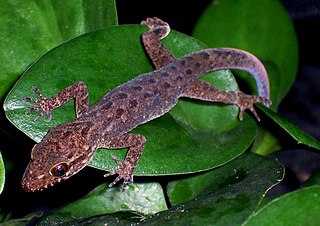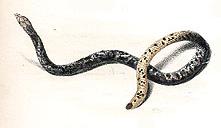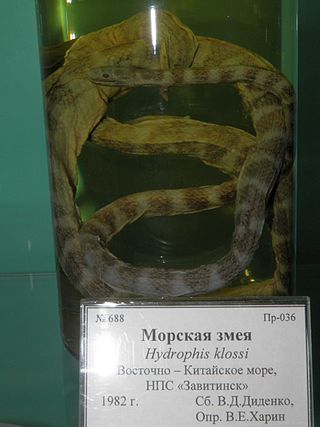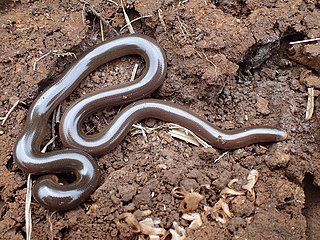| Fimbrios | |
|---|---|
| Scientific classification | |
| Kingdom: | Animalia |
| Phylum: | Chordata |
| Class: | Reptilia |
| Order: | Squamata |
| Suborder: | Serpentes |
| Family: | Xenodermidae |
| Genus: | Fimbrios M.A. Smith, 1921 |
Fimbrios is a genus of snakes of the family Xenodermidae. [2]
| Fimbrios | |
|---|---|
| Scientific classification | |
| Kingdom: | Animalia |
| Phylum: | Chordata |
| Class: | Reptilia |
| Order: | Squamata |
| Suborder: | Serpentes |
| Family: | Xenodermidae |
| Genus: | Fimbrios M.A. Smith, 1921 |
Fimbrios is a genus of snakes of the family Xenodermidae. [2]
The genus Fimbrios is endemic to Southeast Asia. [2]
The following two species are recognized as being valid. [2]
The specific names, klossi and smithi, are in honor of English zoologist Cecil Boden Kloss and British herpetologist Malcolm Arthur Smith, respectively. [3]
The Fimbrios has distinct morphological characteristics such as: 30 to 35 equal-sized maxillary teeth; head not distinct from neck, covered with large shields; eye small, with vertically subelliptic pupil; nostril in the anterior part of a large concave nasal; loreal very large, extending from the nasal to the eye; rostral being separated from the inter-nasals by a horizontal ridge of tissue; rostral, mental and labials with raised, erected edges; a single pair of enlarged chin shields; body slender, cylindrical, scales elliptical, keeled, in 24 to 33 rows at midbody, those of the outer row enlarged; ventrals large, rounded; subcaudals unpaired; tail moderate. [1]

Cyrtodactylus is a diverse genus of Asian geckos, commonly known as bent-toed geckos, bow-fingered geckos, and forest geckos. The genus has about 300 described species as of 2020, which makes it the largest of all gecko genera. As of 2023, Cyrtodactylus santana is the last known species in its family.

The Cylindrophiidae are a monotypic family of secretive, semifossorial, non-venomous snakes containing the genus Cylindrophis found in southeastern Asia. These are burrowing snakes and most have a banded pattern on the belly. Currently, 13 species are recognized, all with no subspecies. Common names include Asian pipe snakes or Asian cylinder snakes.

Rhinophis sanguineus, commonly known as the salty earth snake, is a species of uropeltid snake found in the Western Ghats of India.
Rhinophis travancoricus, commonly known as the Travancore shieldtail or Tamil Nadu earth snake, is a species of uropeltid snake endemic to India.
Uropeltis macrorhyncha is a species of nonvenomous snake in the family Uropeltidae. The species is endemic to India. There are no subspecies that are recognized as being valid.
Uropeltis ocellata is a species of non-venomous shieldtail snake in the family Uropeltidae. The species is indigenous to southern India. There are no subspecies that are recognized as being valid.
Smith's earth snake, also known commonly as the violet shieldtail, is a species of nonvenomous snake in the family Uropeltidae. The species is endemic to India.

Stokes's sea snake is a large species of sea snake in the family Elapidae. It is sometimes placed in its own genus Astrotia. The species is endemic to tropical Indo-Pacific oceanic waters.

Hydrophis klossi, commonly known as Kloss's sea snake or Kloss' sea snake, is a species of sea snake in the family Elapidae. Like all other sea snakes, it is venomous. The species is endemic to the Indian Ocean.

Günther's black snake is a species of poorly known lamprophiid snake endemic to central Africa. It is the only member of the genus, Bothrolycus. This snake is notable as one of the few snakes with notable sexual dimorphism, as well as possessing a small pit anterior to the eye. While superficially similar to the thermal pits of vipers, its function remains unknown.
Uropeltis melanogaster, or Gray's earth snake, is a species of small snake in the family Uropeltidae, endemic to Sri Lanka.

Snakes, like other reptiles, have skin covered in scales. Snakes are entirely covered with scales or scutes of various shapes and sizes, known as snakeskin as a whole. A scale protects the body of the snake, aids it in locomotion, allows moisture to be retained within, alters the surface characteristics such as roughness to aid in camouflage, and in some cases even aids in prey capture. The simple or complex colouration patterns are a property of the underlying skin, but the folded nature of scaled skin allows bright skin to be concealed between scales then revealed in order to startle predators.

Calamaria is a large genus of dwarf burrowing snakes of the family Colubridae. The genus contains 66 recognized species. The genus is endemic to Asia.
Brachyophis is a monotypic genus created for the rear-fanged venomous snake species, Brachyophis revoili, commonly known as Revoil's short snake, which is endemic to Eastern Africa. Three subspecies are recognized as being valid.

Elapotinus is a monotypic genus created for the rear-fanged snake species, Elapotinus picteti. The species is endemic to Madagascar. It is also known commonly as Jan's snake in honor of Italian herpetologist Giorgio Jan. There are no subspecies that are recognized as being valid.
Hypoptophis is a monotypic genus created for the rear-fanged (opisthoglyphous) venomous snake species, Hypoptophis wilsonii. The species, which is endemic to Africa, is in the subfamily Aparallactinae of the family Atractaspididae. There are no subspecies that are recognized as being valid.
The Cameroon racer, Poecilopholis cameronensis, is a species of rear-fanged venomous snake endemic to Africa. Poecilopholis is a monotypic genus created for this species.
Rhinophis philippinus, also known as Peter's earth snake or Peter's Philippine earth snake, is a species of snake in the family Uropeltidae. It is endemic to Sri Lanka.
Letheobia somalica, also known as the highland beaked snake or Ethiopian blind snake, is a species of snake in the family Typhlopidae. It is endemic to Ethiopia.

Bibron's blind snake is a species of snake in the family Typhlopidae. The species is native to southern Africa.